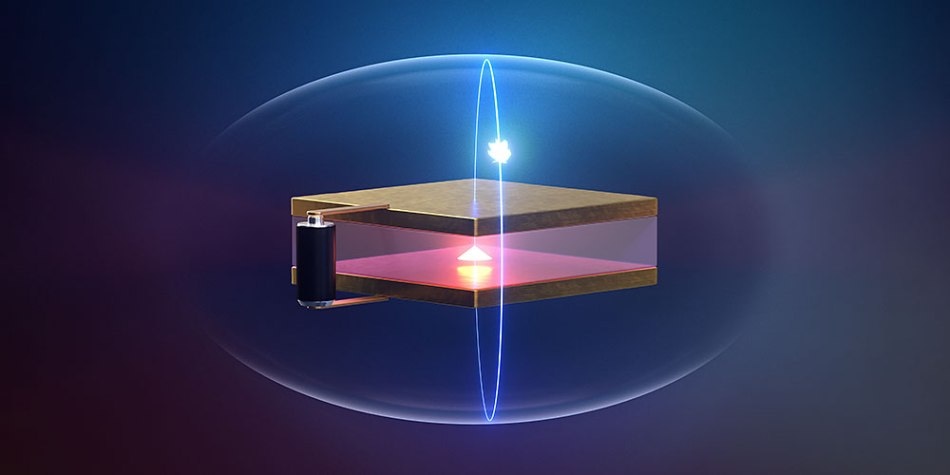Oct 22 2019
Scientists have used a microscopic cavity and successfully developed an efficient quantum-mechanical light-matter interface. Inside the cavity, an artificial atom emits and absorbs a single photon nearly 10 times.
 A microscopic cavity of two highly reflective mirrors is used to allow an enclosed artificial atom (known as a quantum dot) to interact with a single photon. A photon is emitted and reabsorbed up to 10 times by the quantum dot before it is lost. The quantum dot is electrically controlled within a semiconductor chip. (Image credit: University of Basel, Department of Physics)
A microscopic cavity of two highly reflective mirrors is used to allow an enclosed artificial atom (known as a quantum dot) to interact with a single photon. A photon is emitted and reabsorbed up to 10 times by the quantum dot before it is lost. The quantum dot is electrically controlled within a semiconductor chip. (Image credit: University of Basel, Department of Physics)
This paves the way for new possibilities in the field of quantum technology, note physicists from the University of Basel and Ruhr-University Bochum in the Nature journal.
In quantum physics, photons are described as light particles. Making a single photon to interact with a single atom is extremely difficult because of the very small size of the atom. But when the photon is sent past the atom multiple times using mirrors, the probability of an interaction increases considerably.
The researchers used artificial atoms, called quantum dots, to produce the photons. Quantum dots are semiconductor structures that behave quite similar to a single atom in spite of having tens of thousands of atoms accumulated within—upon being optically excited, the energy state of the quantum dots changes, thus emitting a photon.
However, they have the technological advantage that they can be embedded in a semiconductor chip.
Dr Daniel Najer, Department of Physics, University of Basel
The experiment was performed by Najer at the Department of Physics.
System of Quantum Dot and Microcavity
In general, these light particles get scattered in all directions, similar to a light bulb. However, during the experiment, the scientists placed the quantum dot in a cavity that had reflective walls. The emitted photon is reflected back and forth by the curved mirrors up to 10,000 times, thus inducing an interaction between light and matter.
Measurements reveal that a single photon is emitted and absorbed nearly 10 times by the quantum dot. At the quantum scale, the photon is converted into a higher energy state of the artificial atom, and at this point, a new photon is produced. Moreover, this takes place very fast, which is highly desirable when it comes to quantum technological applications: one cycle lasts for only 200 picoseconds.
Although the transformation of an energy quantum from a quantum dot to a photon and vice versa has been well-substantiated theoretically, “nobody has ever observed these oscillations so clearly before,” stated Professor Richard J. Warburton from the Department of Physics at the University of Basel.
Serial Interaction of Light and Matter
The successful experiment is specifically crucial because direct photon-photon interactions do not occur in nature. But a controlled interaction is necessary when it comes to quantum information processing.
The transformation of light into matter based on the laws of quantum physics makes an interaction between individual photons indirectly possible—specifically through the detour of an entanglement of a photon with a single electron spin trapped within the quantum dot.
Quantum gates can be developed through entangled photons if more such photons are involved. This step is crucial in producing photonic qubits, which have the ability to store information through the quantum state of light particles and transmit them over long distances.
International Collaboration
The experiment is performed in the optical frequency range and places high technical demands on the cavity size, which has to be adjusted according to the wavelength, as well as the reflectivity of the mirrors, such that the photon continues to remain in the cavity for as long as possible.
One mirror of the cavity and the semiconductor quantum dots were developed by the group led by Professor Andreas D. Wieck and Dr Arne Ludwig at Ruhr-University Bochum; the other mirror was made at the Université de Lyon. The quantum optics theory group headed by Professor Nicolas Sangouard at the University of Basel offered theoretical support for this study.
The Basel researchers were financially supported by NCCR QSIT, the Swiss National Science Foundation, and Horizon 2020.